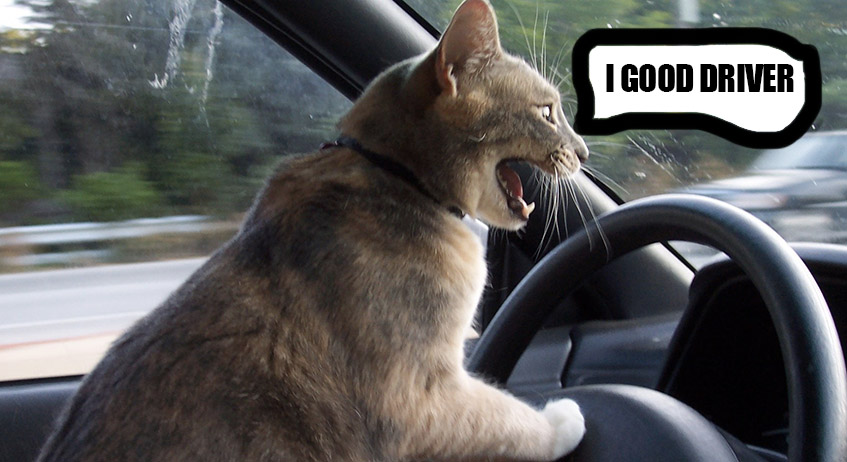
5 reasons why it’s so hard to pass your driving theory test in France
You may be an expat who has found themselves in the unfortunate position of having to retake your driving test in France. This seems to be a common problem among US and Australian citizens, resident in France, but who have been unable to exchange their native driving licence for a French one. (British drivers don’t need to do this, although who knows whether Brexit will change this.) Or maybe, like me, you neglected to learn to drive at home and are now facing the dubious process of learning to do it in France. In either case, the first part of your journey to becoming a legal driver in France is the passing your Code de la Route, ie the French driving theory test.
Now I remembered the British driving theory test from back in the 90s (yes) when I first vaguely tried to learn to drive. It consisted of questions like, “You hit a pedestrian. Should you: a) call an ambulance b) have a drink of brandy c) kick them in the face d) run over them again.” I exaggerate but not much. “This will be easy!” I thought.
I was wrong. So wrong. The French driving theory test is fiendishly difficult. I hated, loathed and resented every moment I spent studying for it. And I’m going to explain why.
1. It’s in French.
This is the most basic difficulty facing expats taking the French driving theory test. You need to have a certain level of French to be able to understand the questions, otherwise the test is just impossible. And even if your French is fine, there’s a good chance you’ll need to learn a whole bunch of vocabulary relating to car mechanics and driving. When I was doing practice tests, there were errors I made because I didn’t know the rule, and errors because I misunderstood the question.
2. You need to answer a very high proportion of questions correctly.
Let’s compare the French and British tests. For the French test, you need to get 35 out of 40 questions right – that’s a 87.5% success rate. Compare that to 43/50 questions for the British test, or a success rate of 86%. So you need to do slightly better in the French test to succeed. Arguably this is compensated by the fact that the British test has 10 more questions, so you need to jump through more hoops to get to the end. So far, I’d say we’re even.
But we’re not done yet. Because where the French test is particularly nasty is that frequently one question is actually made up of two sub question, and you need to answer both correctly to succeed. If we look at this example:

There are two questions: “In the case of fire, the body of the car protects against heat: yes/no” and “Against toxic fumes: yes/no”. You need to answer both questions correctly to get one point; there are no half points in the French test. I’d estimate that around a half of the questions are in this format, meaning in a 40-question test you have to answer around 60 questions, and get a higher proportion right.
3. Often you don’t know how many answers to select.
Again, let’s do a comparison with the British test. Here we have a multiple-choice question; there are four possible response of which only one is correct. This is the format for all questions.

The French test has questions, in the British format, requiring one response. But it also has other multiple-choice questions where you need to select one or more correct responses, but – and here’s the rub – you are not told how many. Again, let’s take an example:

This question is about what equipment it is necessary to have onboard the vehicle. But are one, two, or three of the items necessary? (It cannot be all four.) We are not told, and that adds considerably to the difficulty. Here the answer is A, B and C. If you answered only A and B – WRONG – no points.
4. You’re answering against the clock.
Another disadvantage of the French test is that you have 30 seconds to respond to each question. If you don’t answer within this time, you get zero points. Compare this to the British test where you have 57 minutes overall, and during this time you can flag a question and come back to it later; you can also review all your answers before final submission. No mad panics at the last second picking any old answer because it’s better to choose something than nothing.
5. The content of the practice test is CRAZY difficult.
This final point is something I found far harder than the test being in a foreign language. The subject range is wide, yet also requiring an absurd level of detail. To understand why, let’s go back to May 2016 when the driving theory test in France was overhauled. For our purposes, what that means is that they added more subjects about which you can be asked questions and around 2000 new questions were added. Driving schools, instructors, learner weren’t prepared for this and the pass rate dropped from around 70% to 13%. Yes, 83% of people taking the theory test FAILED. Realising that this wasn’t what they wanted, most of the questions were removed/reviewed (temporarily at least) and pass rates went up again.
Problem solved? Well, no. Because all the practice tests are now 2016 compliant, meaning you still have to learn all this stuff to be allowed to sit the test. Unless you’re an independent candidate, a driving school won’t let you sit the test until you score consistently well in the practice tests. When I finally was able to answer these stupid and irrelevant questions sufficiently well to take the test, I found the test itself to be – how to put it politely? – a piece of piss.
Now some may be thinking this is a good thing: it ensures that new drivers really know their stuff. And I would agree with this were it not for the fact that so many of the questions were just the most irrelevant nonsense, which wasted so much time and diverted attention away from what we should be learning: stopping distances, signals, road signs, procedures of manoeuvres, etc.
Still not convinced? Then let me share some of the questions I genuinely was asked as part of the practice theory test.
What is the highest rating of sunglasses you can wear while driving? 1 / 2 /3 / 4
Car exhaust fumes contribute to the production of greenhouse gases. Yes/No.
How long does it take to cycle 2 kilometres? 5 mins / 8 mins / 15 mins /20 mins
By what percentage does travelling with an empty roof rack increase the consumption of fuel? 3% / 7% / 15% /40%
You can reduce the effects of alcohol by taking an aspirin. Yes/No.
What is the field of vision when travelling at 100 kph? 40% / 75% / 145% / 180%
It’s a driving theory test, not a pub quiz. Can we not stick to practical, useful questions? And if you know the answers, let me know in the comments 🙂
In part, the problem is with the industry that’s built around passing the test. So many services advertise themselves having “thousands of practice questions” that they have to start pushing the boundaries of what’s an acceptable question; there are only so many times you can ask what the speed limit in a town is.
So where does this leave the expat driver who is facing this test? All I can say is don’t underestimate it. You’ll have to put in some serious study. It is possible to succeed, of course. I passed first time, and to reiterate, the actual test was straightforward compared with all the preparation tests. So don’t give up hope, and bonne route!
Have any of you taken the driving theory test in France? Did you find it hard/easy? Have any of you taken the PRACTICAL??!! I’m still doing lessons. Is it hard? Help!






Ann
Hi,
Great piece on the difficulties of the new French theory test. Not daunting at all!
Can you tell me how you studied for it? Did you use an app? A particular book?
Thanks,
Ann
admin
Thank you! My driving school gave me a book and I had access to their website with online tests. I also bought “La code de la route pour les nuls” because the book they gave me wasn’t thorough enough.
Yves
Maybe it was “Le code de la route pour les nuls” (♂ not ♀ 🙂